5 books about Cole, Robert
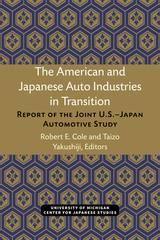
The American and Japanese Auto Industries in Transition
Report of the Joint U.S.–Japan Automotive Study
Robert E. Cole and Taizo Yakushiji, Editors
University of Michigan Press, 1984
This report was prepared for the Policy Board by the U.S. and Japanese research staffs of the Joint U.S.–Japan Automotive Study under the general direction of Professors Paul W. McCracken and Keichi Oshima, with research operations organized and coordinated by Robert E. Cole on the U.S. side, in close communication with the Taizo Yakushiji on the Japanese side. [preface]
In view of the importance of stable, long-term economic relationships between Japan and the United States, automotive issues have to be dealt with in ways consistent with the joint prosperity of both countries. Furthermore, the current economic friction has the potential to adversely affect future political relationships. Indeed, under conditions of economic stagnation, major economic issues inevitably become political issues.
With these considerations in mind, the Joint U.S.–Japan Automotive Study project was started in September 1981 to determine the conditions that will allow for the prosperous coexistence of the respective automobile industries. During this two-year study, we have identified four driving forces that will play a major role in determining the future course of the automotive industry of both countries. These are: (1) consumers’ demands and aspirations vis-à-vis automobiles; (2) flexible manufacturing systems (FMS); (3) rapidly evolving technology; and (4) the internationalization of the automotive industry. [exec. summary]
[more]
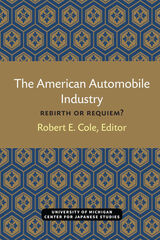
The American Automobile Industry
Rebirth or Requiem?
Robert E. Cole, Editor
University of Michigan Press, 1984
Amid the gloom, indeed the despair, that prevailed among auto industry spokesmen during early 1981, the University of Michigan held the first U.S.-Japan Auto Conference. With all the uncertainty that accompanies a march into new territory, the conference very much resembled a call to arms as industry, union, and government officials sought to comprehend and respond to the Japanese challenge. In the subsequent two conferences in 1982 and 1983, the concerned parties displayed an impressive willingness to roll up their sleeves and get on with creating the conditions for a renewal of the industry. Yet success seemed to elude their efforts, and frustrations mounted as the national recession lengthened and deepened.
It was not until the March 1984 conference that definite change in tone became apparent. By this time, it was clear that the industry was beginning to reap the fruits of its efforts. As Paul McCracken notes in his remarks, the market for new cars was manifesting its traditional high-geared response to improved business conditions, and the voluntary trade restraints were contributing to the ability of the industry to take advantage of this renewed prosperity. In addition, those who know the industry well knew that the major improvements in quality and productivity had been made, and many of the changes responsible for these improvements seem unlikely to be reversed. All this was much on the minds of speakers and participants during the March conference. The various speakers presented an image of people who thought that they were pretty much on the way toward addressing successfully their internal problems of productivity, quality, and marketing. All that remained was to dispose of the external factors that prevented the, from competing on that well-known if elusive "level playing field." [ix]
[more]
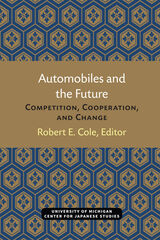
Automobiles and the Future
Competition, Cooperation, and Change
Robert E. Cole, Editor
University of Michigan Press, 1983
At the time of the U.S.-Japan auto conferences in March 1983, the hoped-for economic recovery as manifested in auto sales had revealed itself quite modestly. Three months later, the indicators were more robust and certainly long overdue for those whose livelihood depends on the health of the industry--some of whom are university professors.
With Japanese import restrictions in place until March 1984 and drastically reduced break-even points for domestic manufactures, rising consumer demand holds great promise for the industry. The rapidly rising stock prices of the auto-makers captures well the sense of heightened optimism, as do the various forecasts for improved profits.
While the news is certainly welcome, it nevertheless should be greeted with caution. As Mr. Perkins noted at the conference, "we have a tendency to forget things very quickly. If we have a boom market this year, there is a good chance that a lot of things we learned will be forgotten."
To put the matter differently and more bluntly, with growing prosperity there is the risk that management will fall back into old habits, making impossible the achievement of sustained quality and productivity improvement. Similarly, the commitment to develop cooperative relations with workers and suppliers will weaken. The union will be under membership pressure to retrieve concessions rather than to take the longer-term view. This longer-term view recognizes that "up-front increases" and adherence to existing work rules increasingly come at the sacrifice of future job security. Government policymakers will turn their attention away from the industry. This may not mean a great deal given how weakly focused their attentions has been during the last three years and how mixed and contradictory government auto policies have been for over a decade.
[more]
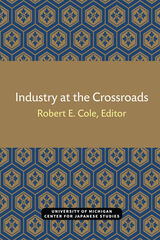
Industry at the Crossroads
Robert E. Cole, Editor
University of Michigan Press, 1982
The mood of the first U of M U.S.-Japan Auto conference in January 1981 could only be described as electric. People wanted to know what our problems were and how we could begin to solve them. Inherent in the latter issue was the questions, what could we learn from the Japanese? One left the conference with a sense that there was a call for action, a mandate to address the problems facing industry.
The mood, about a year later, at the March 1982 U.S.-Japan Auto Conference was far more subdued. While undoubtedly this reflected the stream of statistics confirming the continually depressed state of the industry, another dynamic was possibly operating as well. Whereas the 1981 conference was "electric," a state of mind which flowed from a certain frustration at seemingly overwhelming difficulties and often vague expectations of what we might learn from the Japanese, the 1982 conference was more "workmanlike" in the sense that speakers discussed specifically what progress was being made in addressing problems. This more subdued, pragmatic approach continued throughout wand was reinforced by workshops held the day after the main conference.
Instead of discussing the virtues of the Just-In-Time system in Japan, speakers addressed the practical problems of introducing such a system in the U.S. firms. Instead of railing about the benefits or failings of regulation of the industry, they discussed what we could reasonably expect from regulation. Instead of exhorting the industry to adopt Japanese practices willy-nilly, they focused on some of the limitations of the Japanese model in a range of different areas. Instead of trying to identify some magic key to Japanese success in the automotive industry, they discussed the interrelationships among various factors. At the same, they continued to explore the basic issues transforming the auto industry worldwide. In this connection, they sought to unravel some of the complexities associated with the internalization of the auto industry and trade obligations under the GATT.
[more]
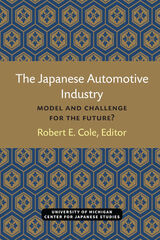
The Japanese Automotive Industry
Model and Challenge for the Future?
Robert E. Cole, Editor
University of Michigan Press, 1981
As the University of Michigan Center for Japanese Studies reflected on the deteriorating position of the domestic auto industry in the fall of 1980, and the strong competitive threat being posed by the Japanese automakers, we were struck by the extraordinary low quality of the public discussion of these critical issues. The national importance of the issues seemed only matched by the superficiality of the analyses being offered. The tendency to think in terms of scapegoats was particularly evident. The Japanese as the basic cause of our problems has been a particularly notable theme. To be sure, cooperation with the Japanese in formulating a rational overall trade policy may be an important part of the solution. It has also been fashionable to blame it all on American auto industry management for not concentrating on the production of small cars when "everyone knew" that was the thing to do. Alternatively, government meddling was blamed for all our problems. Clearly, the complex problem we faced required more penetrating analyses. It seemed therefore, that the time was ripe for a public seminar which moved beyond the rhetoric of the moment and probed some of the deeper causes of our problems and possible directions for future policy.
In holding the January 1981 auto conference, the Center took it as their task to begin addressing the critical issues facing the industry, with particular, but not exclusive, attention to examining the role of the Japanese auto industry. They had in mind not to simply conduct a rational discussion of the trade issue but to probe the sources of Japanese competitive strength, especially those features whose study might profit them.
In these proceedings, they bring those discussions to a wider audience. Question and answer sessions at the conference were necessarily short and a few speakers delivered abbreviated remarks; this volume restores a number of omissions, and provides additional answers to some pertinent questions put by the audience. The Center hopes to encourage the serious problem-solving these complex issues demand. Far too much time has been spent trying to fix the blame. [intro]
[more]
READERS
Browse our collection.
PUBLISHERS
See BiblioVault's publisher services.
STUDENT SERVICES
Files for college accessibility offices.
UChicago Accessibility Resources
home | accessibility | search | about | contact us
BiblioVault ® 2001 - 2024
The University of Chicago Press









